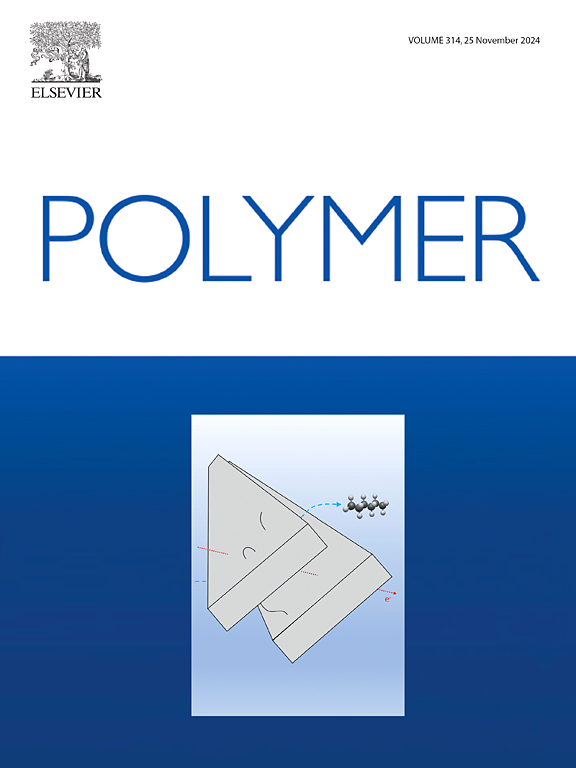High-conductivity PBFDO-based self-adhesive hydrogel for low-hysteresis flexible sensing applications
IF 4.5
2区 化学
Q2 POLYMER SCIENCE
引用次数: 0
Abstract
Conductive hydrogels have emerged as key materials in the field of flexible electronics due to their excellent electrical conductivity and flexibility. Addressing the issues of low electrical conductivity and water-phase incompatibility associated with traditional conductive polymer fillers, this study innovatively developed an n-type high-conductivity polymer poly(benzodifurandione) (PBFDO), which combines ultra-high intrinsic conductivity with exceptional water-phase miscibility. The PAM-PBFDO hydrogel exhibited significantly enhanced conductivity of 43.86 mS m−1, representing a 4.7-fold improvement over pure polyacrylamide (PAM) hydrogel. Additionally, PBFDO's ester carbonyl groups established robust hydrogen bonds with PAM's amide groups, enhancing mechanical strength. Simultaneously, its rigid benzene rings served as physical crosslinks, preventing chain slippage while boosting fatigue resistance and durability. The resulting PAM-PBFDO hydrogel demonstrated remarkable properties, including strong self-adhesion (179 kPa), ultra-low mechanical hysteresis (∼5.6 %), high sensitivity (4.38–33.96), and fast response time (∼40 ms). As a flexible strain sensor, the PAM-PBFDO hydrogel shows great potential in various applications such as human motion monitoring, smart home pressure sensing, and industrial environment monitoring.


用于低滞后柔性传感的高电导率pbdo基自粘水凝胶
导电性水凝胶由于其优异的导电性和柔韧性,已成为柔性电子领域的关键材料。为了解决传统导电聚合物填料的低导电性和水相不相容问题,本研究创新性地开发了一种n型高导电性聚合物聚(苯并二呋喃二酮)(pbdo),该聚合物具有超高的固有导电性和优异的水相混相性。PAM- pbdo水凝胶的电导率显著提高,为43.86 mS m-1,比纯聚丙烯酰胺(PAM)水凝胶提高4.7倍。此外,pbdo的酯羰基与PAM的酰胺基团建立了坚固的氢键,提高了机械强度。同时,它的刚性苯环作为物理交联,防止链滑,同时提高抗疲劳性和耐久性。所得到的pam - pbdo水凝胶具有显著的性能,包括强自粘(179 kPa)、超低机械迟滞(~ 5.6%)、高灵敏度(4.38-33.96)和快速响应时间(~ 40 ms)。pam - pbdo水凝胶作为一种柔性应变传感器,在人体运动监测、智能家居压力传感、工业环境监测等领域显示出巨大的应用潜力。
本文章由计算机程序翻译,如有差异,请以英文原文为准。
求助全文
约1分钟内获得全文
求助全文
来源期刊

Polymer
化学-高分子科学
CiteScore
7.90
自引率
8.70%
发文量
959
审稿时长
32 days
期刊介绍:
Polymer is an interdisciplinary journal dedicated to publishing innovative and significant advances in Polymer Physics, Chemistry and Technology. We welcome submissions on polymer hybrids, nanocomposites, characterisation and self-assembly. Polymer also publishes work on the technological application of polymers in energy and optoelectronics.
The main scope is covered but not limited to the following core areas:
Polymer Materials
Nanocomposites and hybrid nanomaterials
Polymer blends, films, fibres, networks and porous materials
Physical Characterization
Characterisation, modelling and simulation* of molecular and materials properties in bulk, solution, and thin films
Polymer Engineering
Advanced multiscale processing methods
Polymer Synthesis, Modification and Self-assembly
Including designer polymer architectures, mechanisms and kinetics, and supramolecular polymerization
Technological Applications
Polymers for energy generation and storage
Polymer membranes for separation technology
Polymers for opto- and microelectronics.
 求助内容:
求助内容: 应助结果提醒方式:
应助结果提醒方式:


